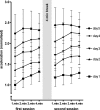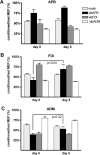Differential modulation of motor cortical plasticity and excitability in early and late phases of human motor learning
- PMID: 17978047
- PMCID: PMC6673358
- DOI: 10.1523/JNEUROSCI.2663-07.2007
Differential modulation of motor cortical plasticity and excitability in early and late phases of human motor learning
Abstract
Different phases of motor skill learning appear to involve different physiological processes, with long-term potentiation (LTP) occurring at existing synapses in early and cortical reorganization involving synaptogenesis in later phases. Here, we test the evolution of skill learning-dependent changes in motor plasticity and excitability in six subjects trained to perform rapid thumb abductions over 5 d. Plasticity was examined using paired-associative stimulation (PAS) of the median nerve and motor cortex to induce LTP-like "PAS given with an interstimulus interval of 25 ms (PAS25)" or long-term depression (LTD)-like "PAS given with an interstimulus interval of 10 ms (PAS10)" plasticity. Excitability was tested by measuring recruitment of motor-evoked-potentials "input-output (IO) curve" and of short-latency intracortical inhibition (SICI curve), and sensorimotor organization (SMO). Task performance improved continuously over 5 d. After practice on day 1, the PAS25 effect reversed from facilitation to inhibition whereas the slope of the IO curve increased and the level of SICI decreased. These effects on IO curve and SICI were still present or even enhanced before the last practice on day 5, and were not changed by it. The effect of proprioceptive input from the trained muscle on SMO was also strengthened before practice on day 5. In contrast, PAS-induced plasticity was not influenced by motor practice on day 5, and had returned to prepractice values. The interference with PAS-induced plasticity suggests that the initial performance improvement relies on increasing the efficacy of existing synaptic connections. However, the long-lasting changes in the IO curve, SICI curve, and SMO suggest that continued practice enhances performance by changing Motor cortical organization. We hypothesize that new synaptic connections might have formed that allow LTP/LTD-susceptibility to be restored without reducing synaptic strength and performance skill.
Figures








References
-
- Chen R. Interactions between inhibitory and excitatory circuits in the human motor cortex. Exp Brain Res. 2004;154:1–10. - PubMed
-
- DiLazzaro V, Restuccia D, Oliviero A, Profice P, Ferrara L, Insola A, Mazzone P, Tonali P, Rothwell JC. Magnetic transcranial stimulation at intensities below active motor threshold activates intracortical inhibitory circuits. Exp Brain Res. 1998;119:265–268. - PubMed
-
- Floyer-Lea A, Matthews PM. Distinguishable brain activation networks for short- and long-term motor skill learning. J Neurophysiol. 2005;94:512–518. - PubMed
-
- Hagbarth KE, Eklund G. Motor effects of muscle vibration in spasticity, rigidity and cerebellar disorders. Electroencephalogr Clin Neurophysiol. 1968;25:407. - PubMed
Publication types
MeSH terms
LinkOut - more resources
Full Text Sources
Miscellaneous
